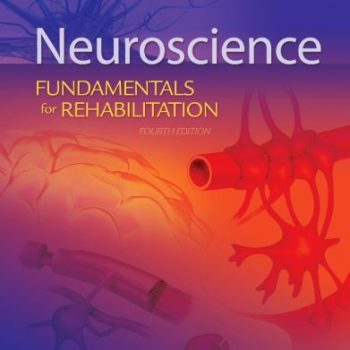Test Bank For Neuroscience Fundamentals Rehabilitation 4th Edition Lundy Ekman
Chapter 2: Physical and Electrical Properties of Cells in the Nervous System
Test Bank
1. Which one of the following neuron structures is specialized for receiving synaptic input from other neurons?
A. Cell body
B. Dendrite
C. Axon
D. Axon hillock
E. Presynaptic terminal
ANS: B
Rationale: Dendrites, with branchlike extensions that serve as the main input sites for the cell and project from the soma, are specialized to receive information from other cells.
2. Which of the following is the structural part of a neuron that releases a neurotransmitter?
A. Dendrite
B. Axon hillock
C. Soma
D. Presynaptic terminal
E. Postsynaptic terminal
ANS: D
Rationale: Axons end in presynaptic terminals, or fingerlike projections, which are the transmitting elements of the neuron. Neurons transmit information about their activity via the release of chemicals called neurotransmitters from the presynaptic terminal into the synaptic cleft.
3. Pseudounipolar cells:
A. Have two dendrites
B. Have two somas
C. Are not neurons
D. Are glial cells
E. Have two axon extensions
ANS: E
Rationale: Pseudounipolar cells, a subclass of bipolar cells, appear to have a single projection from the cell body that divides into two axonal roots. Pseudounipolar cells have two axons and no true dendrites.
4. Retrograde transport:
A. Recycles substances from the axon back to the soma.
B. Moves neurotransmitters from the dendrites to the cell body.
C. Moves substances from the soma toward the axon terminal.
D. Moves neurotransmitters across the synaptic cleft.
E. Moves information from astrocyte to astrocyte.
ANS: A
Rationale: Axoplasmic transport occurs in two directions: anterograde and retrograde. Anterograde transport moves neurotransmitters and other substances from the soma down the axon toward the presynaptic terminal. Retrograde transport moves substances from the synapse back to the soma.
5. Afferent neurons convey information:
A. Between interneurons.
B. From the CNS to skeletal muscles.
C. From peripheral receptors to the CNS.
D. Between the soma and presynaptic terminal.
E. From the CNS to smooth muscles.
ANS: C
Rationale: Afferent neurons carry sensory information from the outer body toward the CNS. Efferent neurons relay commands from the CNS to smooth and striated muscles and glands. Interneurons, the largest class of neurons, act throughout the nervous system, processing information locally or conveying information across short distances.
6. The resting membrane potential is:
A. The same as the membrane equilibrium potential.
B. The voltage difference across a neuron’s cell membrane, maintained by an unequal distribution of one specific ion.
C. Maintained by active transport of sodium ions (Na ) and potassium ions (K ) and passive diffusion of Na , K , and chloride ions (Cl–) through the cell membrane.
D. Typically measured at 70 millivolts (mV) because the intracellular environment is more positively charged than the extracellular environment.
E. Created by a more negative charge inside the membrane than outside because Na is continuously moved inside the cell membrane by an active transport pump.
ANS: C
Rationale: The resting membrane potential is maintained via passive diffusion of ions across the cell membrane and via active transport of Na and K by Na /K pumps.
7. Depolarization occurs when:
A. The membrane potential becomes less negative than the resting membrane potential.
B. The membrane potential becomes more negative than the resting membrane potential.
C. Cl– influx hyperpolarizes the membrane.
D. The presynaptic terminal of a neuron is inhibited by another neuron.
E. All membrane channels are closed, preventing the influx of Na .
ANS: A
Rationale: Sudden changes in membrane potential result from the flow of electrically charged ions through gated channels spanning the cell membrane. The membrane is depolarized when the potential becomes less negative than the resting potential.
8. Local potentials:
A. Are either receptor or synaptic potentials.
B. Spread passively only a short distance along the cell membrane.
C. Result from stimulation of sensory receptors or from the binding of a neurotransmitter with chemical receptor sites on a postsynaptic membrane.
D. Both A and B
E. A, B, and C
ANS: E
Rationale: Local potentials are categorized as either receptor potentials or synaptic potentials, depending on whether they are generated at a peripheral receptor of a sensory neuron or at a postsynaptic membrane. These local potentials can only spread passively and therefore are confined to a small area of the membrane.
9. Which of the following change the electrical potential across the cell membrane?
A. Activation and opening of ligand-gated K channels.
B. Activation and opening of modality-gated Na channels.
C. Activation and opening of voltage-gated Cl– channels.
D. Leak channels, which allow continuous diffusion of small ions.
E. All of the above
ANS: E
Rationale: Neurons function by undergoing rapid changes in electrical potential across the cell membrane. An electrical potential across a membrane exists when the distribution of ions creates a difference in electrical charge on each side of the cell membrane. Four types of membrane channels allow ions to flow across the membrane: leak channels, modality-gated channels, ligand-gated channels, and voltage-gated channels.
10. Propagation of an action potential along an axon is dependent on a(n):
A. Complete myelination of the axon by glial cells.
B. Anterograde diffusion of the electric potential with active generation of new potentials.
C. Rapid repolarization associated with passive diffusion of Cl–.
D. Retrograde diffusion of the electrical potential.
E. Na /K pump moving sufficient quantities of Na into of the cell and K out of the cell.
ANS: B
Rationale: An action potential is a brief, large depolarization in electrical potential that is repeatedly regenerated along the length of an axon. Regeneration allows an action potential to actively spread long distances, transmitting information down the axon to the presynaptic chemical release sites of the presynaptic terminal.


Reviews
There are no reviews yet.